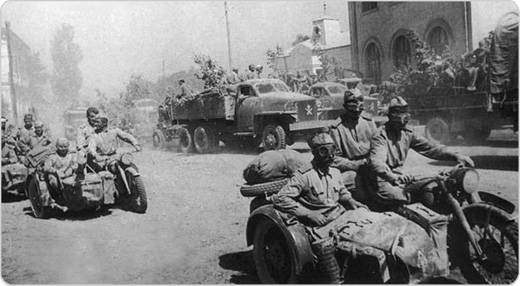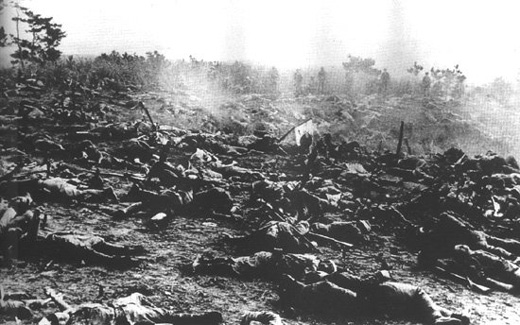Air Operations, Bismarcks
V Bomber Command B-17s attack shipping at Rabaul.
[Air Operations, CBI
- 12 CATF B-25s from the 11th and 22nd Medium Bomb Squadrons, escorted by 7 23rd Fighter Group P-40s, stage through the airfield at Kweilin to mount a bombing attack against the port of Hong Kong and the Kowloon ferry terminal. Attacked by an estimated 21 Japanese fighters, the P-40s down 7 A6M Zeros and 1 Ki-45 'Nick' fighter at about 1330 hours. The bomber gunners claim 7 Japanese aircraft downed and another 8 probables. 1 P-40 is lost over Hong Kong and 1 severely damaged B-25 is abandoned by its crew during the return flight.
- 23rd Fighter Group P-40s shoot down 4 Japanese fighters near Mengtze, China at 1520 hours.
- During the night, 6 of the 11th Medium Bomb Squadron B-25s that attacked Hong Kong during the day return from the airfield at Kweilin to attack the city's power supply. Later, 3 other B-25s attack warehouses in Canton.
- In an effort to cripple the USAAF supply service to China, an estimated 100 Japanese bombers and fighters attack the airfields at Chabua, Dinjan, Mohanbari, and Sookerating in the Assam Valley. Runways and facilities are damaged, 10 US aircraft are destroyed on the ground, and 17 others are damaged. 6 Japanese aircraft are downed by ground fire.
- 2 51st Fighter Group P-40s shoot down 3 Japanese fighters over the Assam region between 1335 and 1410 hours.
Air Operations, Egypt
Continuing their support of the British 8th Army's El Alamein offensive, 30 12th Medium Bomb Group B-25s, escorted by 57th Fighter Group P-40s, attack a wide range of tactical targets. The P-40 escorts down 4 Bf-109s in a morning air action over a Luftwaffe landing ground.
[Air Operations, Europe
BOMBER COMMANDDaylight Ops:
- 12 Bostons are sent to Le Havre again to attack a large merchant ship there. They are forced to turn back because for lack of cloud cover. 3 Mosquitos are sent to Germany but also turn back.
- There are no losses.
Air Operations, New Guinea
3rd Light Bomb Group A-20s attack numerous targets in the Owen Stanley Mountains in support of an Australian Army ground offensive.
[Air Operations, Solomons
- Japanese Navy land-based aircraft and warships and Japanese Army artillery bombard Henderson Field on Guadalcanal throughout the day. Many Cactus Air Force aircraft and facilities are destroyed or damaged and the airfield is closed for extended periods during the day.
- 2 of 5 VMF-121 F4Fs down 3 of 6 A6M Zeros encountered over the Lunga Perimeter at 0940 hours.
- At about 1000 hours, 4 VMF-212 F4Fs strafe 3 Japanese destroyers that are attacking 2 US minesweepers, a fleet tug, and a yacht patrol craft between Tulagi and Lunga Point. The tug is sunk and 1 of the Japanese destroyers is severely damaged by the F4Fs and artillery fire from Guadalcanal. The 4 F4Fs are attacked by several of the 40 A6M Zeros overhead at the time. 1 F4F pilot intentionally rams a Zero, which causes both airplanes to crash. The Marine Corps pilot is rescued and the Japanese pilot is captured.
- In other action over Guadalcanal, VMF-121 and VMF-212 F4Fs claim 7 A6M Zeros during the noon hour; VMF-121 and VMF-212 F4Fs claim 7 Zeros and 4 of 9 G4M 'Betty' bombers at 1430 hours; and a VF-71 F4F claims a Zero at 1500 hours.
- In distant action, 5 Cactus Air Force SBDs take off from the Fighter-1 field at about noon, and at 1300 hours they attack a Japanese surface force composed of a light cruiser and 5 destroyers that are advancing toward Guadalcanal through New Georgia Sound. The light cruiser is severely damaged by a direct hit and a near miss, and 1 destroyer is damaged by a near miss. 3 67th Fighter Squadron P-39s that attack the cruiser at 1420 hours score 1 near miss; 5 VB-6 SBDs that attack at 1500 hours score a near miss on the damaged destroyer and another on the light cruiser; 4 Cactus Air Force SBDs, 4 P-39s, and 3 F4Fs attack at 1530, and 1 of the P-39s scores a near miss on the damaged destroyer; 6 11th Heavy Bombardment Group B-17s based in the New Hebrides attack from high altitude at 1600 hours, and 2 hits are claimed. With that, the cruiser is abandoned and scuttled with torpedoes and the 5 destroyers withdraw.
Battle of El Alamein
The situation of the 10th Arm Div in the corridor through the minefields has become very difficult by the early hours of the morning, but at 3:30a.m. Montgomery confirms that the attempt to break through must go on whatever the cost. At the middle of the day Montgomery decides to modify his plan of attack, shifting the pivot of the offensive to the north. The main attack is given to the Australian 9th Div, supported by the 1st Arm Div. There is violent fighting in the area of Kidney Ridge. Although by the end of the day thay have lost perhaps 250 tanks, this can be accepted since 15th Pzr has less than 40 left. When Rommel arrives in the evening the 9th Australian Div in the north has already started attacking toward the sea. They make important gains which attract Rommel's attention.
The tankers Proserpina and Luisiano, loaded with fuel for the nearly empty tanks of Rommel's vehicles, are sunk in Tobruk harbor.
[Battle of Santa Cruz
The Japanese navy mounts a major operation in support of the offensive on Guadalcanal, sending 4 battleships and the carriers Shokaku, Zuiho and Junyo as well as numerous cruisers and destroyers. The carriers are to send aircraft to Henderson Field once the army has captured it and only a report to that effect has brought it so close to the island. The Americans have 2 carriers in the operations, the Enterprise (CV-6) and the Hornet (CV-8), but unlike the Japanese their one battleship is in close attendance to provide supporting antiaircraft fire. As at Midway, the Japanese force is split into several groups, in this instance four. The battleships are separate from the carriers which themselves have fewer defensive guns than their American counterparts.
The Junyo, with 55 aircraft, is even in a separate group from the rest of the carriers. A second disadvantage in the design of the Japanese carriers is that their bridges are too small to accommodate tha admiral's staff necessary if no other large ships are in company. However, despite these disadvantages, the Japanese have 212 planes on their carriers and the Americans 171. Both sides will receive help, especially in scouting, from land-based aircraft.
The American patrols are first to find the enemy but a strike launched later goes astray. Both sides prepare for action on the 26th.
[Bermuda
A squadron of American aircraft carriers sails for North Africa for Operation TORCH.
The Soviet Ural M-72 Motorcycle |
 |
Eastern Front
After a period devoted to regrouping, the Germans renew their offensive with attacks by III Pzr Corps south of the Terek River in the Caucasus.
SOUTHERN USSRAs the Germans continue to blast their wary into the Red October and Barrikady factory complexes, the Soviet 64th Army launches a fresh attack toward Stalingrad, meeting fierce German resistance. In the Caucasus, an assault by tne III Panzer Corps toward Nalchik forces the Soviet 37th Army to retreat.[MORE]
[Guadalcanal
Japanese artillery and aircraft are very active during the day but ground attacks are withheld until nightfall, when 2 regiments attack the 1st Battalion, 7th Marines, and the 3rd Battalion, 164th Infantry, on the southern flank of the Lunga perimeter. Other enemy forces attack the 2nd Battalion, 7th Marines, east of Hill 67 and the Matanikau River. Both attacks are repulsed with considerable losses on both sides and a lull in the ground action follows.[MORE]
Results of the Japanese Failed Assault |
 |
New Guinea
The US Army's 2nd Battalion, 126th Infantry Regiment has reached Jaure, but has suffered high casualties from disease, especially malaria, in its overland march. The 32nd Infantry Division commander, Maj-Gen Edwin F. Harding, requests that the remainder of the division be airlifted to required locations to maintain the combat effectiveness of his units.
[Soviet Union, Strategy
For Operation URANUS the Stavka will deploy the Southwestern Front (340,000 troops), Don Front (292,000 troops) and Stalingrad Front (383,000 troops).
[